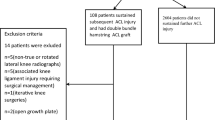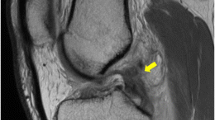Abstract
Purpose
To compare clinical outcomes and tunnel widening following anterior cruciate ligament reconstruction (ACLR) performed with an all-inside technique (Group A) or with a bioabsorbable tibial screw and suspensory femoral fixation (Group B).
Methods
Tunnel widening was assessed using computed tomography (CT) and a previously validated analytical best fit cylinder technique at approximately 1-year following ACLR. Clinical follow-up comprised evaluation with IKDC, KSS, Tegner, Lysholm scores, and knee laxity assessment.
Results
The study population comprised 22 patients in each group with a median clinical follow-up of 24 months (range 21–27 months). The median duration between ACLR and CT was 13 months (range 12–14 months). There were no significant differences in clinical outcome measures between groups. There were no differences between groups with respect to femoral tunnel widening. However, there was a significantly larger increase in tibial tunnel widening, at the middle portion, in Group B (2.4 ± 1.5 mm) compared to Group A (0.8 ± 0.4 mm) (p = 0.027), and also at the articular portion in Group B (1.5 ± 0.8 mm) compared to Group A (0.8 ± 0.8 mm) (p = 0.027).
Conclusion
Tibial tunnel widening after ACLR using hamstring tendon autograft is significantly greater with suspensory femoral fixation and a bioabsorbable tibial interference screw when compared to an all-inside technique at a median follow-up of 2 years. The clinical relevance of this work lies in the rebuttal of concerns arising from biomechanical studies regarding the possibility of increased tunnel widening with an all-inside technique.
Level of evidence
III.



Similar content being viewed by others
References
Burnham JM, Malempati CS, Carpiaux A, Ireland ML, Johnson DL (2017) Anatomic femoral and tibial tunnel placement during anterior cruciate ligament reconstruction: anteromedial portal all-inside and outside-in techniques. Arthrosc Tech 6(2):e275–e282
Colombet P, Graveleau N, Jambou S (2016) Incorporation of hamstring grafts within the tibial tunnel after anterior cruciate ligament reconstruction: magnetic resonance imaging of suspensory fixation versus interference screws. Am J Sports Med 44(11):2838–2845
Crespo B, Aga C, Wilson KJ, Pomeroy SM, LaPrade RF, Engebretsen L, Wijdicks CA (2014) Measurements of bone tunnel size in anterior cruciate ligament reconstruction: 2D versus 3D computed tomography model. J Exp Orthop 1(1):2
De Beus A, Koch JE, Hirschmann A, Hirschmann MT (2017) How to evaluate bone tunnel widening after ACL reconstruction—a critical review. Muscles Ligaments Tendons J 7(2):230–239
Fahey M, Indelicato PA (1994) Bone tunnel enlargement after anterior cruciate ligament replacement. Am J Sports Med 22(3):410–414
Fink C, Zapp M, Benedetto KP, Wolfgang H, Hoser C, Rieger M (2001) Tibial tunnel enlargement following anterior cruciate ligament reconstruction with patellar tendon autograft. Arthroscopy 17(2):138–143
Harris NL, Indelicato PA, Bloomberg MS, Meister K, Wheeler DL (2002) Radiographic and histologic analysis of the tibial tunnel after allograft anterior cruciate ligament reconstruction in goats. Am J Sports Med 30(3):368–373
Höher J, Möller HD, Fu FH (1998) Bone tunnel enlargement after anterior cruciate ligament reconstruction: fact or fiction? Knee Surg Sports Traumatol Arthrosc 6(4):231–240
Iorio R, Di Sanzo V, Vadalà A, Conteduca J, Mazza D, Redler A et al (2013) ACL reconstruction with hamstrings: how different technique and fixation devices influence bone tunnel enlargement. Eur Rev Med Pharmacol Sci 17(21):2956–2961
Irrgang JJ, Ho H, Harner CD, Fu FH (1998) Use of the international knee documentation committee guidelines to assess outcome following anterior cruciate ligament reconstruction. Knee Surg Sports Traumatol Arthrosc 6(2):107–114
Karikis I, Ejerhed L, Sernert N, Rostgård-Christensen L, Kartus J (2017) Radiographic tibial tunnel assessment after anterior cruciate ligament reconstruction using hamstring tendon autografts and biocomposite screws: a prospective study with 5-Year follow-up. Arthroscopy 33(12):2184–2194
Kim SG, Kurosawa H, Sakuraba K, Ikeda H, Takazawa S, Takazawa Y (2005) Development and application of an inside to-out drill bit for anterior cruciate ligament reconstruction. Arthroscopy 21 (8):1012
Lanzetti RM, Monaco E, De Carli A, Grasso A, Ciompi A, Sigillo R, Argento G, Ferretti A (2016) Can an adjustable-loop length suspensory fixation device reduce femoral tunnel enlargement in anterior cruciate ligament reconstruction? A prospective computer tomography study. Knee 23(5):837–841
Lubowitz JH, Ahmad CS, Anderson K (2011) All-inside anterior cruciate ligament graft-link technique: Second generation, no-incision anterior cruciate ligament reconstruction. Arthroscopy 27(5):717–727
Lubowitz JH, Schwartzberg R, Smith P (2015) Cortical suspensory button versus aperture interference screw fixation for knee anterior cruciate ligament soft-tissue allograft: a prospective, randomized controlled trial. Arthroscopy 31(9):1733–1739
Marchant MH Jr, Willimon SC, Vinson E et al (2010) Comparison of plain radiography, computed tomography, and magnetic resonance imaging in the evaluation of bone tunnel widening after anterior cruciate ligament reconstruction. Knee Surg Sports Traumatol Arthrosc 18(8):1059–1064
Mayr R, Heinrichs CH, Eichinger M, Coppola C, Schmoelz W, Attal R (2015) Biomechanical comparison of 2 anterior cruciate ligament graft preparation techniques for tibial fixation: adjustable-length loop cortical button or interference screw. Am J Sports Med 43(6):1380–1385
Mayr R, Smekal V, Koidl C, Coppola C, Fritz J, Rudisch A, Kranewitter C, Attal R (2017) Tunnel widening after ACL reconstruction with aperture screw fixation or all-inside reconstruction with suspensory cortical button fixation: volumetric measurements on CT and MRI scans. Knee 24(5):1047–1054
McAdams TR, Biswal S, Stevens KJ, Beaulieu CF, Mandelbaum BR (2008) Tibial aperture bone disruption after retrograde versus antegrade tibial tunnel drilling: a cadaveric study. Knee Surg Sports Traumatol Arthrosc 16(9):818–822
Mermerkaya MU, Atay OA, Kaymaz B, Bekmez S, Karaaslan F, Doral MN (2014) Anterior cruciate ligament reconstruction using a hamstring graft: a retrospective comparison of tunnel widening upon use of two different femoral fixation methods. Knee Surg Sports Traumatol Arthrosc 23(8):2283–2291
Monaco E, Bachmaier S, Fabbri M, Lanzetti RM, Wijdicks CA, Ferretti A (2018) Intraoperative workflow for all-inside anterior cruciate ligament reconstruction: an in vitro biomechanical evaluation of preconditioning and knot tying. Arthroscopy 34(2):538–545
Monaco E, Fabbri M, Lanzetti RM, Del Duca A, Labianca L, Ferretti A (2017) Biomechanical comparison of four coupled fixation systems for ACL reconstruction with bone socket or full-tunnel on the tibial side. Knee 24(4):705–710
Mulcahey MK, David TS, Epstein DM, Alaia MJ, Montgomery KD (2014) Transtibial versus anteromedial portal anterior cruciate ligament reconstruction using soft-tissue graft and expandable fixation. Arthroscopy 30(11):1461–1467
Osti M, Krawinkel A, Hoffelner T, Benedetto KP (2015) Quantification of tibial bone loss in antegrade versus retrograde tunnel placement for anterior cruciate ligament reconstruction. Int Orthop 39(8):1611–1614
Prentice HA, Lind M, Mouton C, Persson A, Magnusson H, Gabr A, Seil R, Engebretsen L, Samuelsson K, Karlsson J, Forssblad M, Haddad FS, Spalding T, Funahashi TT, Paxton LW, Maletis GB (2018) Patient demographic and surgical characteristics in anterior cruciate ligament reconstruction: a description of registries from six countries. Br J Sports Med 52(11):716–722
Robbrecht C, Claes S, Cromheecke M, Mahieu P, Kakavelakis K, Victor J, Bellemans J, Verdonk P (2014) Reliability of a semi-automated 3D-CT measuring method for tunnel diameters after anterior cruciate ligament reconstruction: a comparison between soft-tissue single-bundle allograft vs. autograft. Knee 21(5):926–931
Rodeo SA, Arnoczky SP, Torzilli PA, Hidaka C, Warren RF (1993) Tendon healing in a bone tunnel. A biomechanical and histological study in the dog. J Bone Jt Surg Am 75(12):1795–1803
Sabzevari S, Rahnemai-Azar AA, Shaikh HS, Arner JW, Irrgang JJ, Fu FH (2017) Increased lateral tibial posterior slope is related to tibial tunnel widening after primary ACL reconstruction. Knee Surg Sports Traumatol Arthrosc 25(12):3906–3913
Smith PA, Stannard JP, Pfeiffer FM, Kuroki K, Bozynski CC, Cook JL (2016) Suspensory versus interference screw fixation for arthroscopic anterior cruciate ligament reconstruction in a translational large-animal model. Arthroscopy 32(6):1086–1097
Vadalà A, Iorio R, De Carli A, Argento G, Di Sanzo V, Conteduca F et al (2007) The effect of accelerated, brace free, rehabilitation on bone tunnel enlargement after ACL reconstruction using hamstring tendons: a CT study. Knee Surg Sports Traumatol Arthrosc 15(4):365–371
Funding
No external funding was used.
Author information
Authors and Affiliations
Corresponding author
Ethics declarations
Conflict of interest
Edoardo Monaco, Andrea Ferretti and Angelo De Carli declares to be consultant for Arthrex.
Ethical approval
All procedure performed in the study involving humans participants were in accordance with the ethical standards of the institutional research committee and with the 1964 Helsinki declaration and its later amendments or comparable ethical standards.
Rights and permissions
About this article
Cite this article
Monaco, E., Fabbri, M., Redler, A. et al. Anterior cruciate ligament reconstruction is associated with greater tibial tunnel widening when using a bioabsorbable screw compared to an all-inside technique with suspensory fixation. Knee Surg Sports Traumatol Arthrosc 27, 2577–2584 (2019). https://doi.org/10.1007/s00167-018-5275-x
Received:
Accepted:
Published:
Issue Date:
DOI: https://doi.org/10.1007/s00167-018-5275-x




